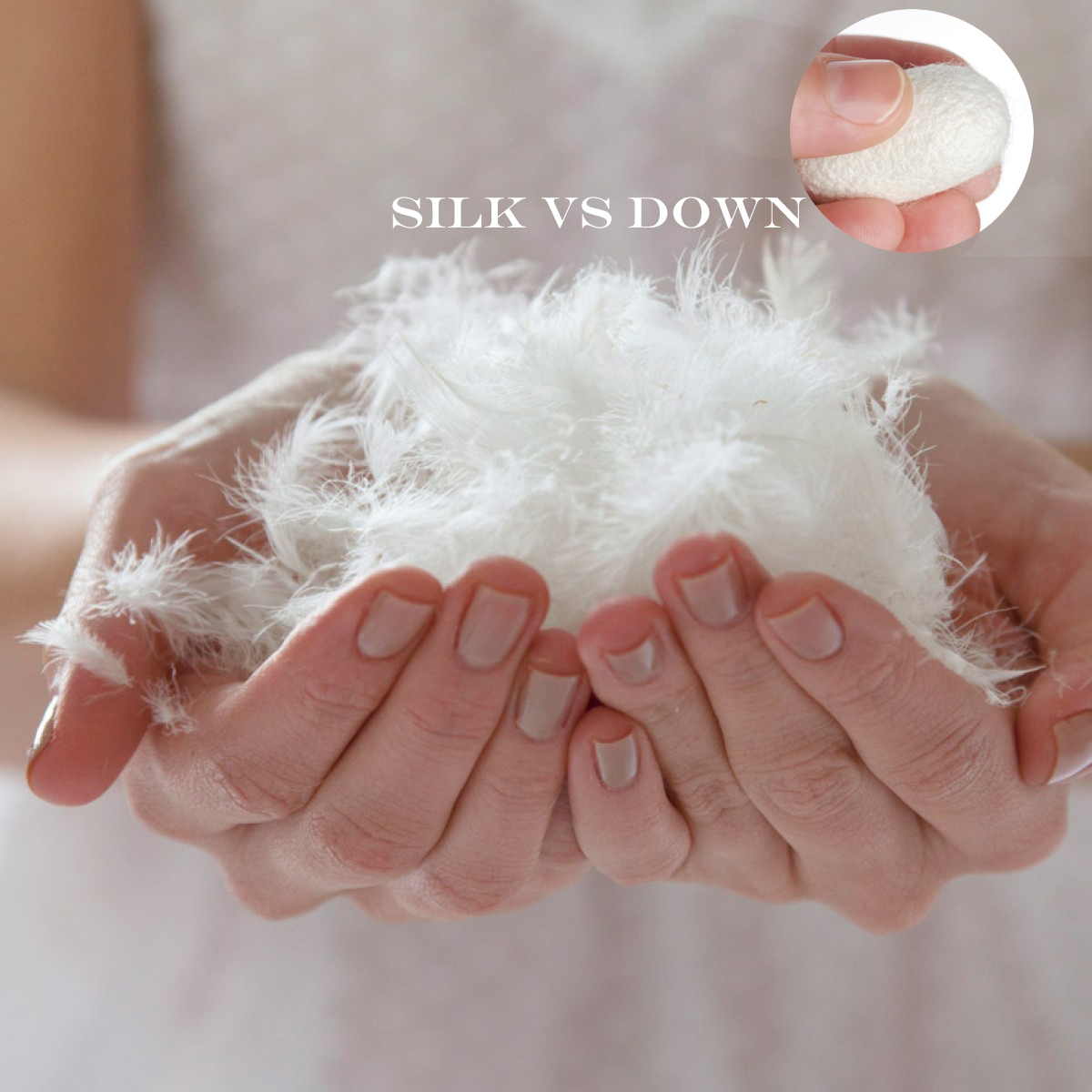Down duvet is the traditional king of the duvet market for its exceptional ability to keep warmth inside on a freezing winter night. Before air conditioning became commonplace, owning a down duvet or not basically determines how your sleep quality is in winter.
However, as more and more households become equipped with air conditioners, down duvets are gradually losing ground to silk duvets which are occupying a significant portion of the bedding market now. Why did this change happen? Let’s make a quick comparison between the two types of duvets.
1. Price
Prices for down comforters (let’s pick a standard size for our comparison, say, Queen size) are approximately $250-$350 on Amazon, and $250-$400 for silk comforters (summer and all-season included). On more specialized websites, the pricing of both down and silk comforters can vary greatly, going up to the 4-digit range. Overall, pricing for both types of comforters are similar.
2. Warmth
Down comforters trap all heat emanated by your body inside because air pockets formed by down feathers inside the comforterare stationary. This make down comforters great if your bedroom is very cold during winter. However, if your room is moderately air-conditioned, sleeping in a down comforter will cause you to sweat excessively after a certain period of time passes due to the temperature inside the comforter keeps going up.
Silk comforters are thinner and more breathable due to the mesh structure of the filling, so generally speaking they tend to be a bit “cooler”. Of course, for a moderately air-conditioned environment, silk comforters are better since it will regulate temperature around your body naturally by letting excessive heat escape. This is also why silk comforters can be used in a variety of temperatures throughout the year while down comforters are used exclusively for winter.
3. Comfort / Sleep Quality
Down:
– Down comforters are relatively heavy compared to silk comforters, which means sleepers have a harder time moving around while in a down comforter and have more restricted blood flow around the body.
– Down comforters are warm, although sometimes too warm which causes excessive perspiration. If the shell of the comforter/duvet cover are not made with material with good moisture wicking capabilities, oversweating creates a damp sleeping environment which is not very comfortable. Oversweating also causes dehydration which may interrupt your sleep, and leave you fatigued in the morning.
– Down comforters are relatively rigid and need to be tucked in around the shoulders to keep warm. This needs to be done repeatedly throughout the night. Not doing so makes the stomach area warm but shoulders cold which causes your nervous system to be unable to rest.
– Most down comforters keep their filling evenly distributed by sewing equal portions of down feathers in separate pockets in the comforter. However, lower quality down comforters have the problem of cold spots because even within the smaller pockets the down feathers can still “bunch up” and create a denser cluster that occupies just a portion of the pocket instead of spreading throughout. This creates an area that is completely uncovered through which heat escapes freely. Obviously, this is not ideal for insulation.
Silk:
– Silk comforters are light in nature and sleeping in a silk comforter is very relaxing. However, for a restless sleeper, silk comforters tend to get pushed off the bed often.
– Silk comforters are great temperature regulators as well as great moisture wickers, which means that you will rest at a suitable temperature throughout the night, and even if you are a sweater, the comforter will help remove excessive moisture and keep the environment sufficiently dry.
– Silk comforters are soft which means they drape naturally over the contours of your body no matter how you move around (except when you push them off). Your body will be well protected from the cold and no partially-cold-partially-hot feelings will occur.
– Silk comforters’ fillings are sheet-like and evenly distributed in terms of thickness. The sides of the filling are oftentimes tacked on the edge of comforter shell, forcing the filling to stay stationary, so there will be no cold spots.
4. Maintenance:
Down comforters tend to use cotton shell which needs to be washed often, since cotton is not very resistant to mold and bacteria/dust mites. However, down comforters are best washed with drycleaning, which means that maintaining a down comforter well is not only costly but also time-consuming. The overheating issue of down comforters further exacerbates this problem since more sweat tends to lead to easier formation of molding spots.
Silk comforters are also not water-washable. However, compared to down comforters, silk is anti-bacterial, anti-mold and anti-acarid, which means that aside from airing your comforters once in a while to expel any residual moisture in the filling, a silk comforter doesn’t need drycleaning nearly as much. Also, since silk comforters can be used throughout the year and are thinner than down comforters, one does not need to worry about putting the comforter away nor looking for extra storage space.
To conclude, unless your bedroom is extremely cold during winter or you toss and turn a lot during sleep, silk comforters are better than down comforters by a rather large margin for similar prices.

